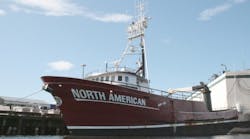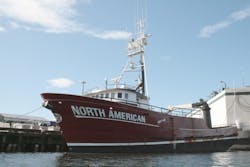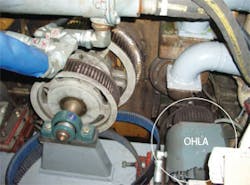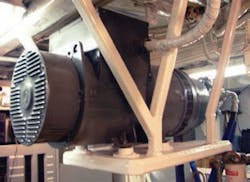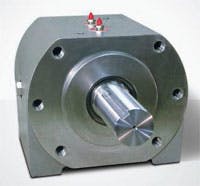Commercial fishing boats burn hundreds of gallons of fuel simply travelling from home port to destination, then back again. Traditional drive systems typically have the boat’s captain choose an arbitrary speed, and because time is money, engines often operate at near their top cruising speed — usually in excess of 1000 rpm. In the case of the North American, a 35-yr old crab boat based in Seattle, running the engine 1025 rpm consumes 42 gal of fuel per hour. The North American is an 110-ft house forward fishing vessel capable of carrying a full load of king crabs weighing 170,000 lb. It ventures north from Seattle for the Alaskan king crab fishing season.
Adding substantially to total fuel consumption while in transit is an auxiliary generator, which provides electrical power for lights, accommodations, and other functions. The diesel engine driving the generator is governed to run continuously at 1800 rpm. Considering it usually takes days to reach a fishing site — such as the Bering Sea, between Alaska and Russia — the generator itself consumes hundreds of gallons of fuel and spews out an equivalent amount of emissions per excursion. The North American overcomes both of these liabilities by monitoring fuel consumption and using hydraulics to run its generator during travel.
Dynamic Duo Cuts Fuel Consumption
Sten Skaar, captain of the North American, revealed that he now uses a FloScan fuel flow meter to monitor instantaneous fuel consumption of the boat. Available from FloScan Instrument Co. Inc., Seattle, the meter provides Skaar with a readout of fuel consumption in gal/hr. Skaar found that by cutting engine speed from 1025 down to 860 rpm reduces fuel consumption from 42 gal/hr to only 23 gal/hr. He explained that reducing engine speed does not sacrifice much of the boat’s travel speed — only about 1/2 knot. So the slightly slower speed is more than offset by the substantial fuel savings.
The other technique for cutting fuel consumption is eliminating the need for a diesel-driven generator to provide electrical power while in transit. The generator itself would consume several gallons of fuel per hour, so the combined fuel savings from running the boat’s engine at a slower speed and not using fuel for a generator can cut fuel consumption by as much as half.
Instead of a stand-alone generator, the North American uses the Gen-Tech system, a patented work boat power generation system consisting of a closed-loop hydrostatic transmission (HST) powering a generator from the vessel’s main engine. The Gen-Tech system is offered by Gen- Tech Global LLC, Seattle. The North American’s engine drives a Sauer- Danfoss variable-displacement axialpiston pump, which feeds a Sauer- Danfoss fixed-displacement motor. A Sauer-Danfoss Plus+1 control monitors key parameters of the HST and automatically adjusts pump displacement so that the motor always drives the generator at its optimum speed of 1800 rpm — whether the captain runs the North American at full speed for maximum power, or throttles back to conserve fuel.
Besides the constant speed produced by the hydrostatic motor, another benefit of the HST is that the generator can be mounted in an out-of-the-way location. In the case of the North American, it’s mounted near the ceiling of the engine room. And as is typical of hydraulics, the hydraulic motor is much smaller than the diesel engine that would otherwise drive the generator. This makes the generator more compact, lighter, and eliminates the problems otherwise associated with plumbing exhaust from a diesel engine.
Negating Overhung Loads
One of the challenges of this application was determining how to best transmit power from the North American’s main engine — a Caterpillar Model 399, capable of delivering 1125 hp — to the hydraulic pump. Mobile hydraulic pumps are generally designed for flange mounting. In this case, the pump has an SAE size D flange with splined shaft.
However, the North American’s engine was not equipped with a pump drive flange, so it would have to be driven by a chain or belt drive from the engine. Erling Skaar, president of Gen-Tech Global, chose to use a Gates Polychain synchronous belt drive with 2.8:1 speed reduction ratio because it would be quieter and require less maintenance than a chain drive. However, belt (and chain) drives transmit a side (overhung) load to their driven shaft. And because flange-mounted pumps are not equipped with bearings to accommodate heavy side loads, Skaar had to resolve this challenge.
He decided to transmit power from the belt drive to the HST pump through a model 1036S overhung load adapter (OHLA) from Zero-Max Inc., Plymouth, Minn. The OHLAs from Zero-Max come in a wide variety of configurations. One important feature they all share is heavy-duty bearings to support any overhung load instead of transmitting it to the driven shaft of the load. The 1036S has spherical roller bearings for added durability in this application. Its housing is made of 25-ksi cast iron with shafts of 130 ksi steel. The North American also uses another OHLA for driving a second variable-displacement pump. Together, the pumps accommodate pressure to 3000 psi and are capable of combined flow to 120 gpm.
The OHLA eliminates the need for a secondary gearbox to operate the hydraulic pumps, which can be more costly. Also, the OHLA provides more stability in the drive train than a gearbox would. Most important, the OHLA enhances motor operation by eliminating premature motor or pump failure due to radial or axial overhung loads on the pump and motor shaft. In high seas, violent shifting motion multiplies power train stress, so the OHLA’s stability role is even more important than in calm operating conditions.
Skaar revealed, “Our system maximizes the operating efficiency of the primary engine with the help of the overhung load adaptor, so running a secondary engine (for a generator) is unnecessary. The additional load on the main engine from operating the Gen-Tech system is negligible, and therefore highly efficient and fuel efficient. There is no added wear to the engine or connecting components. Thanks to the OHLA’s rugged design, we’re assured of smooth and reliable pump and generator operation. That’s extremely important in the adverse and hostile environments that these fishing vessels are subjected to.”
Future Applications
Skaar says the North American saves $2300 or more in fuel costs during a typical eight-day excursion with the Gen-Tech system — not to mention the lower emissions associated with the lower fuel consumption. He explained that the system is a product of more than nine years of innovative research, rigorous testing, and development of new technology.
Gen-Tech’s patented controller and software design “learns” the power requirement for the input to the hydraulic pumps from the ship’s main engine. Using that information, the controller then adjusts the displacement of the hydraulic pump to maintain stable frequency and voltage through the entire speed range of the main engine.
For more information about overhung load adaptors, call Zero-Max at (800) 533-1731, e-mail [email protected], or visit www.zero-max.com.
For more information about the Gen- Tech System, call (206) 634-3399, email [email protected], or visit www.gentechglobal.com.
